Challenges Facing Uniformed Protective Services in Promoting Active Citizenship Within Diverse Communities
VerifiedAdded on 2023/06/11
|12
|3070
|443
AI Summary
This article explores the challenges faced by uniformed protective services in promoting active citizenship within diverse communities. It covers the key features of society, citizenship, diversity, concept of community cohesion, and active citizenship. It also delves into the rights and responsibilities of individuals and the protective services, including human rights, legal rights, and human rights organizations.
Contribute Materials
Your contribution can guide someone’s learning journey. Share your
documents today.
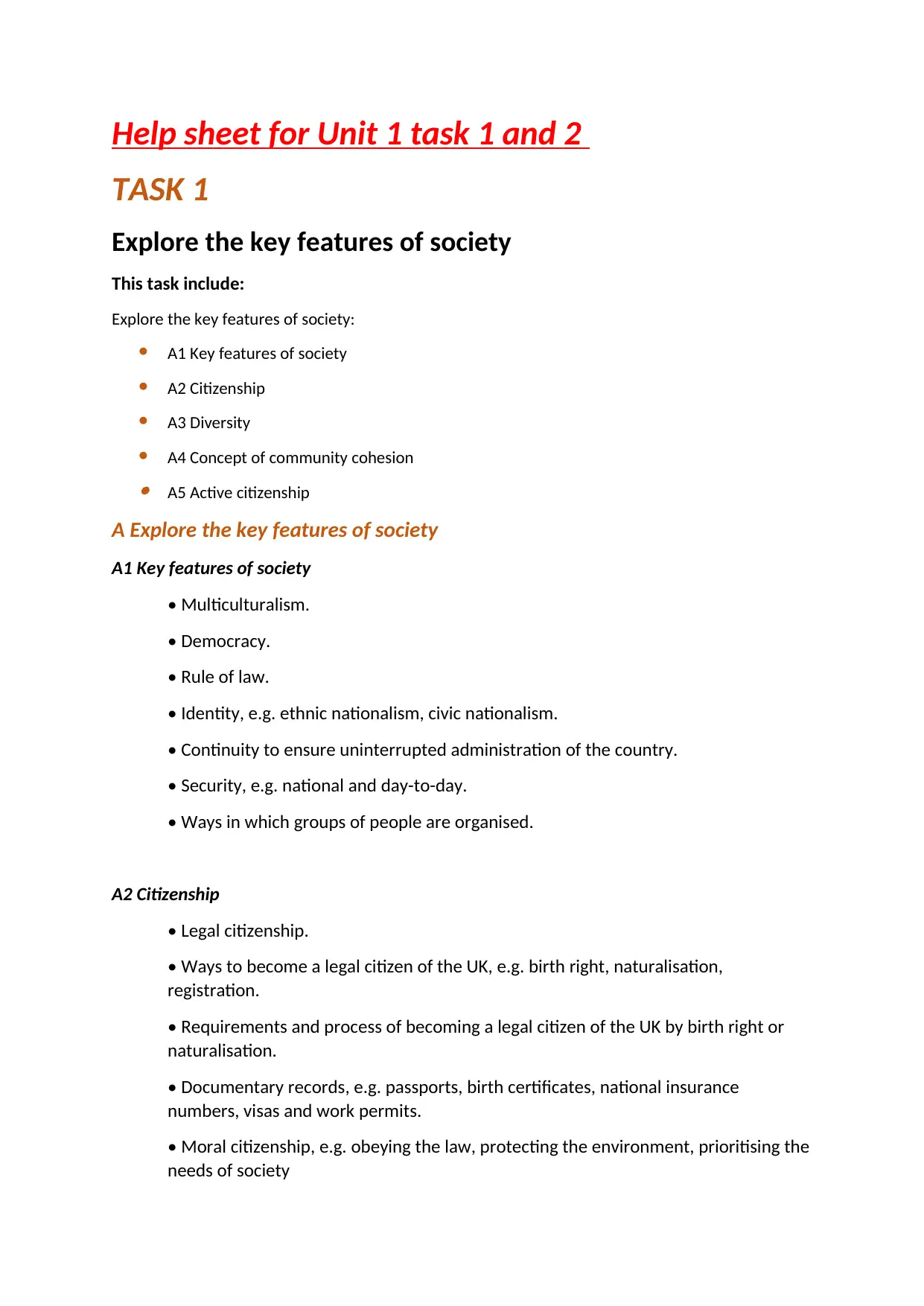
Help sheet for Unit 1 task 1 and 2
TASK 1
Explore the key features of society
This task include:
Explore the key features of society:
A1 Key features of society
A2 Citizenship
A3 Diversity
A4 Concept of community cohesion A5 Active citizenship
A Explore the key features of society
A1 Key features of society
• Multiculturalism.
• Democracy.
• Rule of law.
• Identity, e.g. ethnic nationalism, civic nationalism.
• Continuity to ensure uninterrupted administration of the country.
• Security, e.g. national and day-to-day.
• Ways in which groups of people are organised.
A2 Citizenship
• Legal citizenship.
• Ways to become a legal citizen of the UK, e.g. birth right, naturalisation,
registration.
• Requirements and process of becoming a legal citizen of the UK by birth right or
naturalisation.
• Documentary records, e.g. passports, birth certificates, national insurance
numbers, visas and work permits.
• Moral citizenship, e.g. obeying the law, protecting the environment, prioritising the
needs of society
TASK 1
Explore the key features of society
This task include:
Explore the key features of society:
A1 Key features of society
A2 Citizenship
A3 Diversity
A4 Concept of community cohesion A5 Active citizenship
A Explore the key features of society
A1 Key features of society
• Multiculturalism.
• Democracy.
• Rule of law.
• Identity, e.g. ethnic nationalism, civic nationalism.
• Continuity to ensure uninterrupted administration of the country.
• Security, e.g. national and day-to-day.
• Ways in which groups of people are organised.
A2 Citizenship
• Legal citizenship.
• Ways to become a legal citizen of the UK, e.g. birth right, naturalisation,
registration.
• Requirements and process of becoming a legal citizen of the UK by birth right or
naturalisation.
• Documentary records, e.g. passports, birth certificates, national insurance
numbers, visas and work permits.
• Moral citizenship, e.g. obeying the law, protecting the environment, prioritising the
needs of society
Secure Best Marks with AI Grader
Need help grading? Try our AI Grader for instant feedback on your assignments.
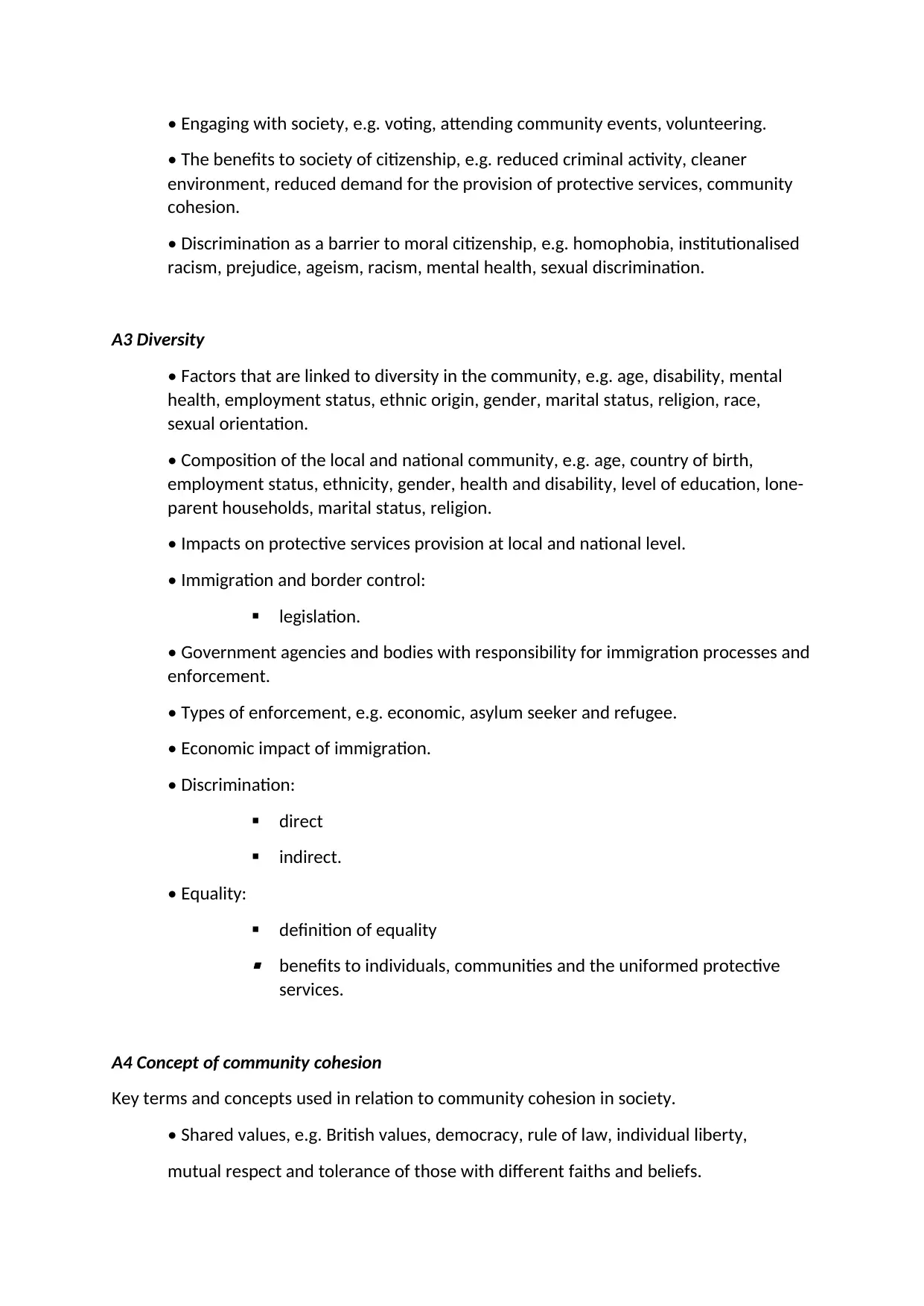
• Engaging with society, e.g. voting, attending community events, volunteering.
• The benefits to society of citizenship, e.g. reduced criminal activity, cleaner
environment, reduced demand for the provision of protective services, community
cohesion.
• Discrimination as a barrier to moral citizenship, e.g. homophobia, institutionalised
racism, prejudice, ageism, racism, mental health, sexual discrimination.
A3 Diversity
• Factors that are linked to diversity in the community, e.g. age, disability, mental
health, employment status, ethnic origin, gender, marital status, religion, race,
sexual orientation.
• Composition of the local and national community, e.g. age, country of birth,
employment status, ethnicity, gender, health and disability, level of education, lone-
parent households, marital status, religion.
• Impacts on protective services provision at local and national level.
• Immigration and border control:
legislation.
• Government agencies and bodies with responsibility for immigration processes and
enforcement.
• Types of enforcement, e.g. economic, asylum seeker and refugee.
• Economic impact of immigration.
• Discrimination:
direct
indirect.
• Equality:
definition of equality
benefits to individuals, communities and the uniformed protective
services.
A4 Concept of community cohesion
Key terms and concepts used in relation to community cohesion in society.
• Shared values, e.g. British values, democracy, rule of law, individual liberty,
mutual respect and tolerance of those with different faiths and beliefs.
• The benefits to society of citizenship, e.g. reduced criminal activity, cleaner
environment, reduced demand for the provision of protective services, community
cohesion.
• Discrimination as a barrier to moral citizenship, e.g. homophobia, institutionalised
racism, prejudice, ageism, racism, mental health, sexual discrimination.
A3 Diversity
• Factors that are linked to diversity in the community, e.g. age, disability, mental
health, employment status, ethnic origin, gender, marital status, religion, race,
sexual orientation.
• Composition of the local and national community, e.g. age, country of birth,
employment status, ethnicity, gender, health and disability, level of education, lone-
parent households, marital status, religion.
• Impacts on protective services provision at local and national level.
• Immigration and border control:
legislation.
• Government agencies and bodies with responsibility for immigration processes and
enforcement.
• Types of enforcement, e.g. economic, asylum seeker and refugee.
• Economic impact of immigration.
• Discrimination:
direct
indirect.
• Equality:
definition of equality
benefits to individuals, communities and the uniformed protective
services.
A4 Concept of community cohesion
Key terms and concepts used in relation to community cohesion in society.
• Shared values, e.g. British values, democracy, rule of law, individual liberty,
mutual respect and tolerance of those with different faiths and beliefs.
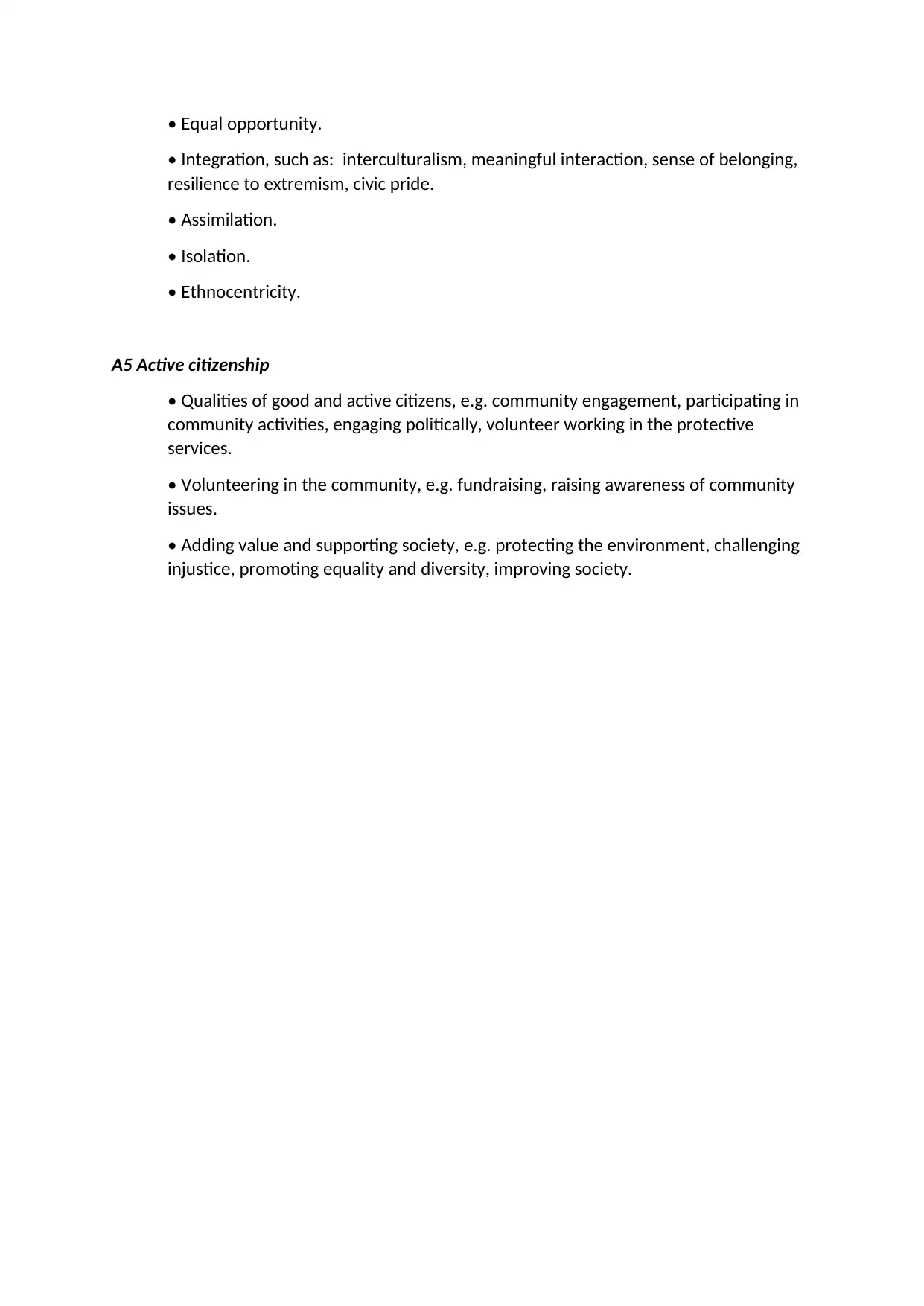
• Equal opportunity.
• Integration, such as: interculturalism, meaningful interaction, sense of belonging,
resilience to extremism, civic pride.
• Assimilation.
• Isolation.
• Ethnocentricity.
A5 Active citizenship
• Qualities of good and active citizens, e.g. community engagement, participating in
community activities, engaging politically, volunteer working in the protective
services.
• Volunteering in the community, e.g. fundraising, raising awareness of community
issues.
• Adding value and supporting society, e.g. protecting the environment, challenging
injustice, promoting equality and diversity, improving society.
• Integration, such as: interculturalism, meaningful interaction, sense of belonging,
resilience to extremism, civic pride.
• Assimilation.
• Isolation.
• Ethnocentricity.
A5 Active citizenship
• Qualities of good and active citizens, e.g. community engagement, participating in
community activities, engaging politically, volunteer working in the protective
services.
• Volunteering in the community, e.g. fundraising, raising awareness of community
issues.
• Adding value and supporting society, e.g. protecting the environment, challenging
injustice, promoting equality and diversity, improving society.
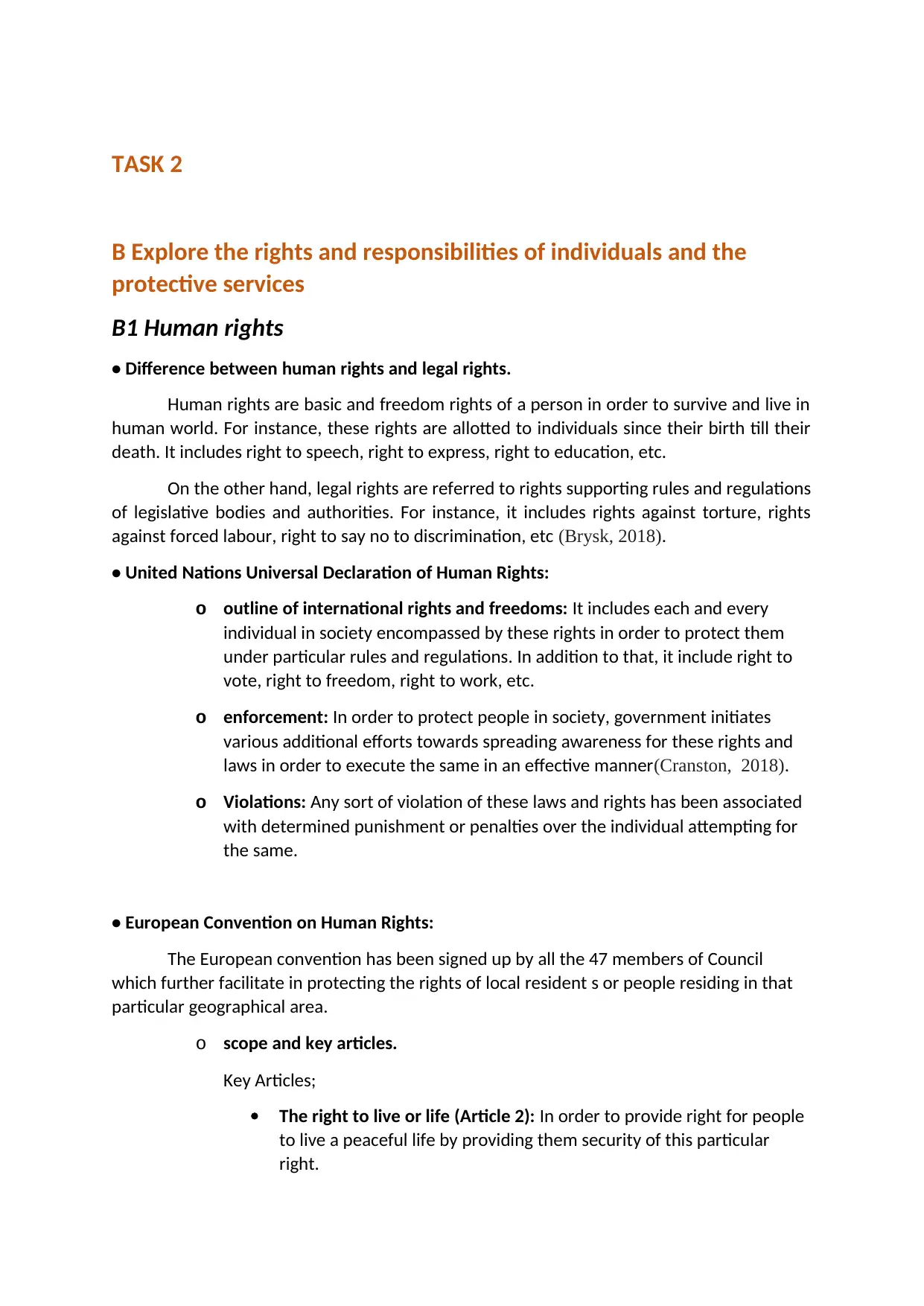
TASK 2
B Explore the rights and responsibilities of individuals and the
protective services
B1 Human rights
• Difference between human rights and legal rights.
Human rights are basic and freedom rights of a person in order to survive and live in
human world. For instance, these rights are allotted to individuals since their birth till their
death. It includes right to speech, right to express, right to education, etc.
On the other hand, legal rights are referred to rights supporting rules and regulations
of legislative bodies and authorities. For instance, it includes rights against torture, rights
against forced labour, right to say no to discrimination, etc (Brysk, 2018).
• United Nations Universal Declaration of Human Rights:
o outline of international rights and freedoms: It includes each and every
individual in society encompassed by these rights in order to protect them
under particular rules and regulations. In addition to that, it include right to
vote, right to freedom, right to work, etc.
o enforcement: In order to protect people in society, government initiates
various additional efforts towards spreading awareness for these rights and
laws in order to execute the same in an effective manner(Cranston, 2018).
o Violations: Any sort of violation of these laws and rights has been associated
with determined punishment or penalties over the individual attempting for
the same.
• European Convention on Human Rights:
The European convention has been signed up by all the 47 members of Council
which further facilitate in protecting the rights of local resident s or people residing in that
particular geographical area.
o scope and key articles.
Key Articles;
The right to live or life (Article 2): In order to provide right for people
to live a peaceful life by providing them security of this particular
right.
B Explore the rights and responsibilities of individuals and the
protective services
B1 Human rights
• Difference between human rights and legal rights.
Human rights are basic and freedom rights of a person in order to survive and live in
human world. For instance, these rights are allotted to individuals since their birth till their
death. It includes right to speech, right to express, right to education, etc.
On the other hand, legal rights are referred to rights supporting rules and regulations
of legislative bodies and authorities. For instance, it includes rights against torture, rights
against forced labour, right to say no to discrimination, etc (Brysk, 2018).
• United Nations Universal Declaration of Human Rights:
o outline of international rights and freedoms: It includes each and every
individual in society encompassed by these rights in order to protect them
under particular rules and regulations. In addition to that, it include right to
vote, right to freedom, right to work, etc.
o enforcement: In order to protect people in society, government initiates
various additional efforts towards spreading awareness for these rights and
laws in order to execute the same in an effective manner(Cranston, 2018).
o Violations: Any sort of violation of these laws and rights has been associated
with determined punishment or penalties over the individual attempting for
the same.
• European Convention on Human Rights:
The European convention has been signed up by all the 47 members of Council
which further facilitate in protecting the rights of local resident s or people residing in that
particular geographical area.
o scope and key articles.
Key Articles;
The right to live or life (Article 2): In order to provide right for people
to live a peaceful life by providing them security of this particular
right.
Secure Best Marks with AI Grader
Need help grading? Try our AI Grader for instant feedback on your assignments.
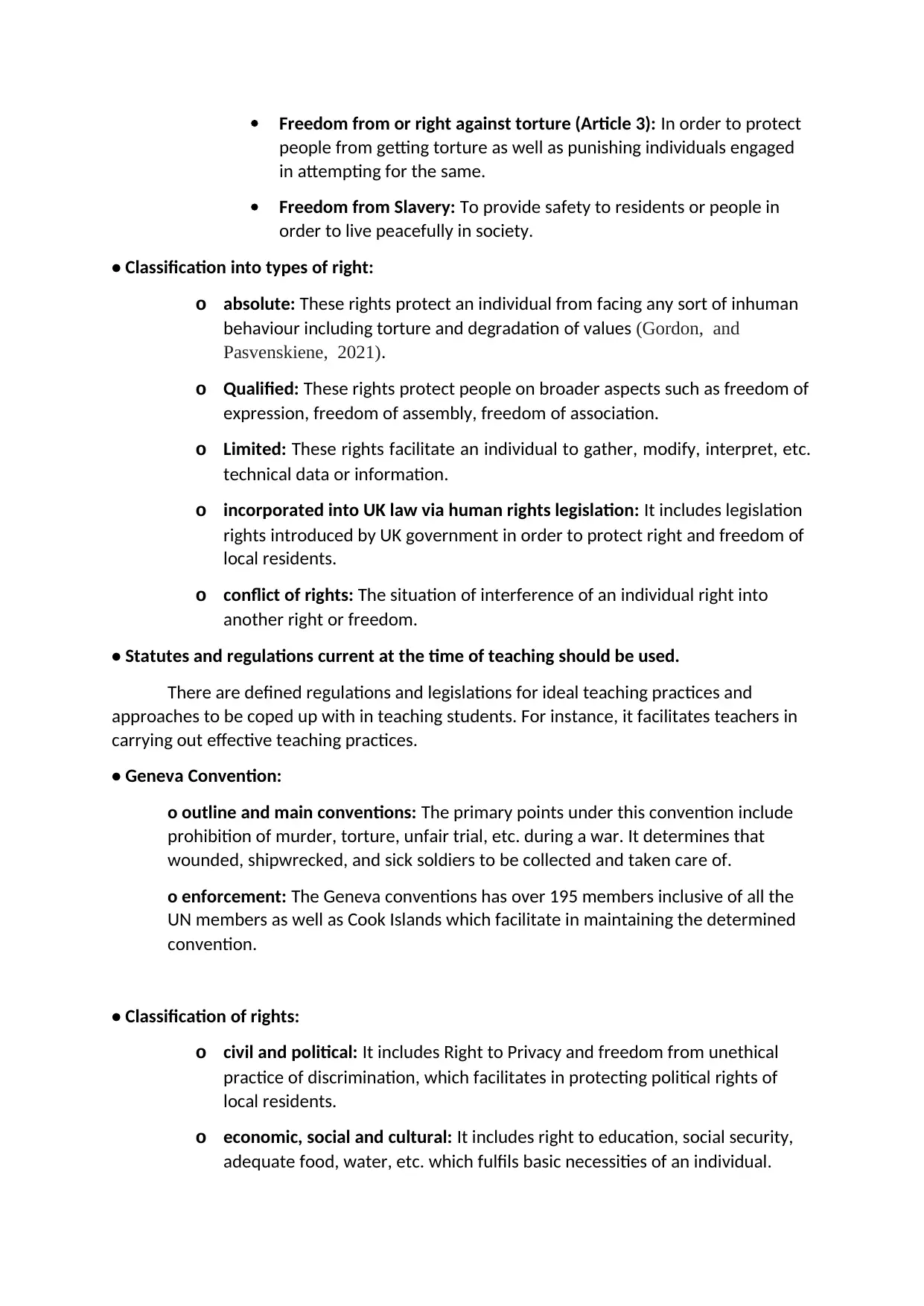
Freedom from or right against torture (Article 3): In order to protect
people from getting torture as well as punishing individuals engaged
in attempting for the same.
Freedom from Slavery: To provide safety to residents or people in
order to live peacefully in society.
• Classification into types of right:
o absolute: These rights protect an individual from facing any sort of inhuman
behaviour including torture and degradation of values (Gordon, and
Pasvenskiene, 2021).
o Qualified: These rights protect people on broader aspects such as freedom of
expression, freedom of assembly, freedom of association.
o Limited: These rights facilitate an individual to gather, modify, interpret, etc.
technical data or information.
o incorporated into UK law via human rights legislation: It includes legislation
rights introduced by UK government in order to protect right and freedom of
local residents.
o conflict of rights: The situation of interference of an individual right into
another right or freedom.
• Statutes and regulations current at the time of teaching should be used.
There are defined regulations and legislations for ideal teaching practices and
approaches to be coped up with in teaching students. For instance, it facilitates teachers in
carrying out effective teaching practices.
• Geneva Convention:
o outline and main conventions: The primary points under this convention include
prohibition of murder, torture, unfair trial, etc. during a war. It determines that
wounded, shipwrecked, and sick soldiers to be collected and taken care of.
o enforcement: The Geneva conventions has over 195 members inclusive of all the
UN members as well as Cook Islands which facilitate in maintaining the determined
convention.
• Classification of rights:
o civil and political: It includes Right to Privacy and freedom from unethical
practice of discrimination, which facilitates in protecting political rights of
local residents.
o economic, social and cultural: It includes right to education, social security,
adequate food, water, etc. which fulfils basic necessities of an individual.
people from getting torture as well as punishing individuals engaged
in attempting for the same.
Freedom from Slavery: To provide safety to residents or people in
order to live peacefully in society.
• Classification into types of right:
o absolute: These rights protect an individual from facing any sort of inhuman
behaviour including torture and degradation of values (Gordon, and
Pasvenskiene, 2021).
o Qualified: These rights protect people on broader aspects such as freedom of
expression, freedom of assembly, freedom of association.
o Limited: These rights facilitate an individual to gather, modify, interpret, etc.
technical data or information.
o incorporated into UK law via human rights legislation: It includes legislation
rights introduced by UK government in order to protect right and freedom of
local residents.
o conflict of rights: The situation of interference of an individual right into
another right or freedom.
• Statutes and regulations current at the time of teaching should be used.
There are defined regulations and legislations for ideal teaching practices and
approaches to be coped up with in teaching students. For instance, it facilitates teachers in
carrying out effective teaching practices.
• Geneva Convention:
o outline and main conventions: The primary points under this convention include
prohibition of murder, torture, unfair trial, etc. during a war. It determines that
wounded, shipwrecked, and sick soldiers to be collected and taken care of.
o enforcement: The Geneva conventions has over 195 members inclusive of all the
UN members as well as Cook Islands which facilitate in maintaining the determined
convention.
• Classification of rights:
o civil and political: It includes Right to Privacy and freedom from unethical
practice of discrimination, which facilitates in protecting political rights of
local residents.
o economic, social and cultural: It includes right to education, social security,
adequate food, water, etc. which fulfils basic necessities of an individual.
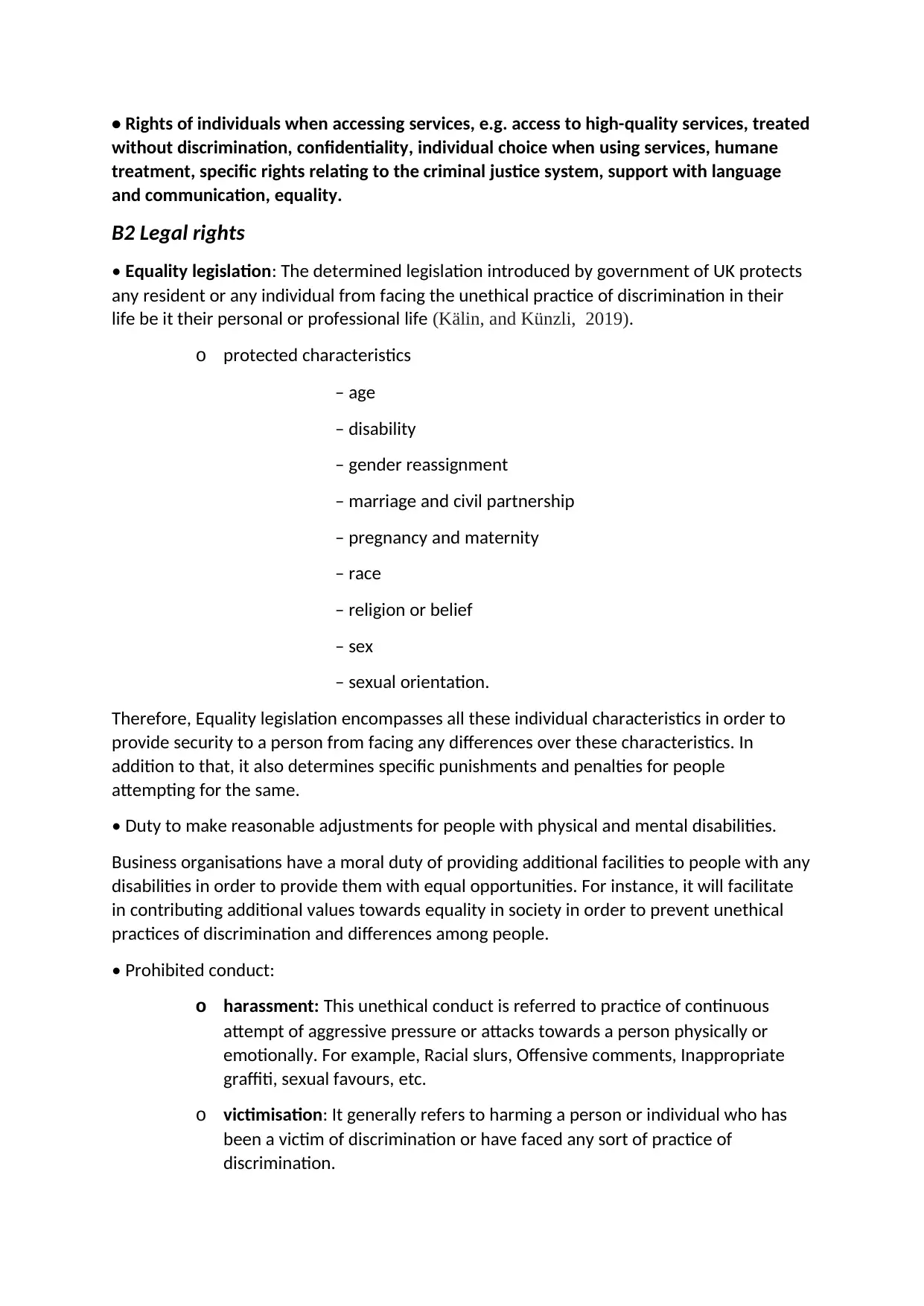
• Rights of individuals when accessing services, e.g. access to high-quality services, treated
without discrimination, confidentiality, individual choice when using services, humane
treatment, specific rights relating to the criminal justice system, support with language
and communication, equality.
B2 Legal rights
• Equality legislation: The determined legislation introduced by government of UK protects
any resident or any individual from facing the unethical practice of discrimination in their
life be it their personal or professional life (Kälin, and Künzli, 2019).
o protected characteristics
– age
– disability
– gender reassignment
– marriage and civil partnership
– pregnancy and maternity
– race
– religion or belief
– sex
– sexual orientation.
Therefore, Equality legislation encompasses all these individual characteristics in order to
provide security to a person from facing any differences over these characteristics. In
addition to that, it also determines specific punishments and penalties for people
attempting for the same.
• Duty to make reasonable adjustments for people with physical and mental disabilities.
Business organisations have a moral duty of providing additional facilities to people with any
disabilities in order to provide them with equal opportunities. For instance, it will facilitate
in contributing additional values towards equality in society in order to prevent unethical
practices of discrimination and differences among people.
• Prohibited conduct:
o harassment: This unethical conduct is referred to practice of continuous
attempt of aggressive pressure or attacks towards a person physically or
emotionally. For example, Racial slurs, Offensive comments, Inappropriate
graffiti, sexual favours, etc.
o victimisation: It generally refers to harming a person or individual who has
been a victim of discrimination or have faced any sort of practice of
discrimination.
without discrimination, confidentiality, individual choice when using services, humane
treatment, specific rights relating to the criminal justice system, support with language
and communication, equality.
B2 Legal rights
• Equality legislation: The determined legislation introduced by government of UK protects
any resident or any individual from facing the unethical practice of discrimination in their
life be it their personal or professional life (Kälin, and Künzli, 2019).
o protected characteristics
– age
– disability
– gender reassignment
– marriage and civil partnership
– pregnancy and maternity
– race
– religion or belief
– sex
– sexual orientation.
Therefore, Equality legislation encompasses all these individual characteristics in order to
provide security to a person from facing any differences over these characteristics. In
addition to that, it also determines specific punishments and penalties for people
attempting for the same.
• Duty to make reasonable adjustments for people with physical and mental disabilities.
Business organisations have a moral duty of providing additional facilities to people with any
disabilities in order to provide them with equal opportunities. For instance, it will facilitate
in contributing additional values towards equality in society in order to prevent unethical
practices of discrimination and differences among people.
• Prohibited conduct:
o harassment: This unethical conduct is referred to practice of continuous
attempt of aggressive pressure or attacks towards a person physically or
emotionally. For example, Racial slurs, Offensive comments, Inappropriate
graffiti, sexual favours, etc.
o victimisation: It generally refers to harming a person or individual who has
been a victim of discrimination or have faced any sort of practice of
discrimination.
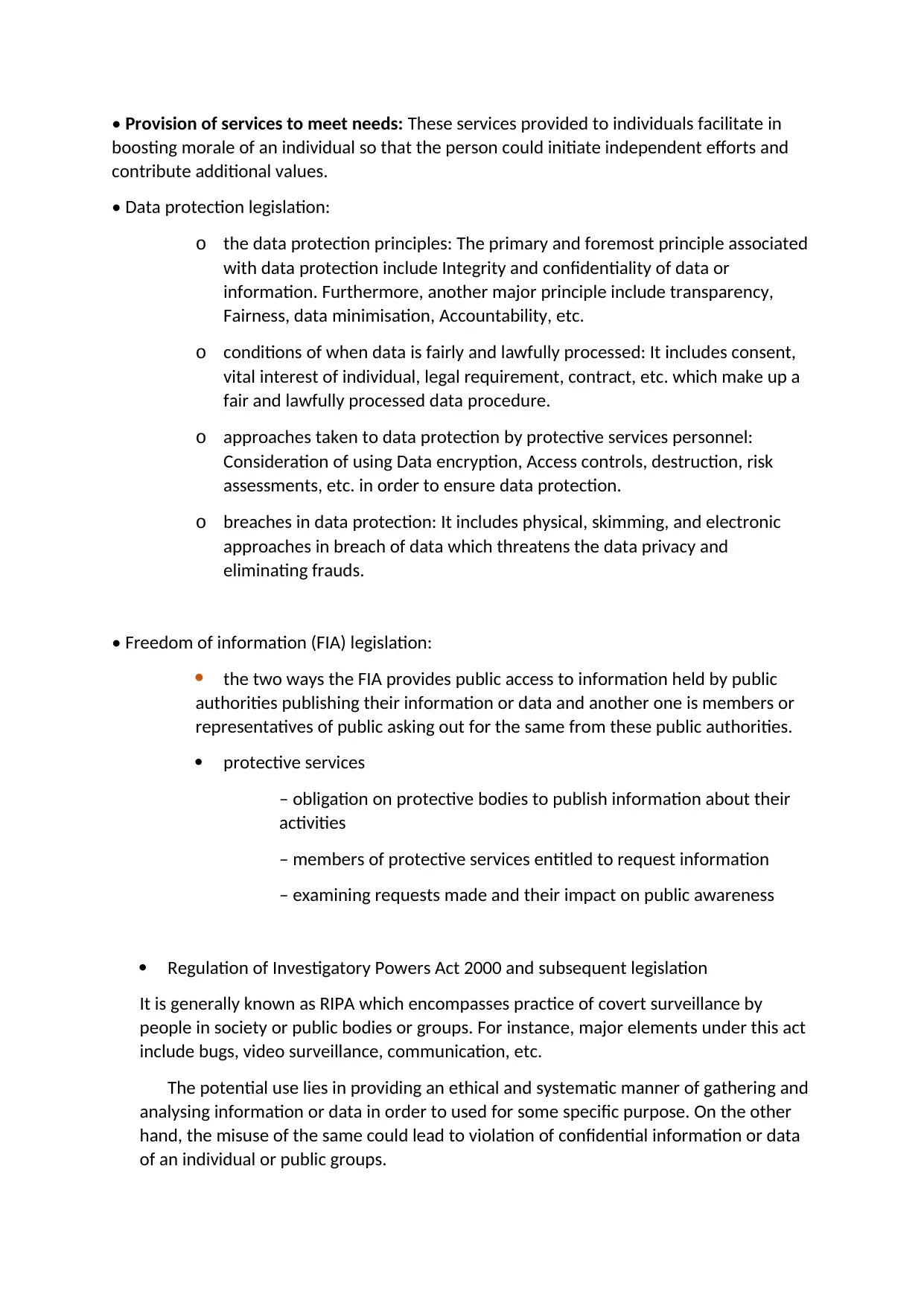
• Provision of services to meet needs: These services provided to individuals facilitate in
boosting morale of an individual so that the person could initiate independent efforts and
contribute additional values.
• Data protection legislation:
o the data protection principles: The primary and foremost principle associated
with data protection include Integrity and confidentiality of data or
information. Furthermore, another major principle include transparency,
Fairness, data minimisation, Accountability, etc.
o conditions of when data is fairly and lawfully processed: It includes consent,
vital interest of individual, legal requirement, contract, etc. which make up a
fair and lawfully processed data procedure.
o approaches taken to data protection by protective services personnel:
Consideration of using Data encryption, Access controls, destruction, risk
assessments, etc. in order to ensure data protection.
o breaches in data protection: It includes physical, skimming, and electronic
approaches in breach of data which threatens the data privacy and
eliminating frauds.
• Freedom of information (FIA) legislation:
the two ways the FIA provides public access to information held by public
authorities publishing their information or data and another one is members or
representatives of public asking out for the same from these public authorities.
protective services
– obligation on protective bodies to publish information about their
activities
– members of protective services entitled to request information
– examining requests made and their impact on public awareness
Regulation of Investigatory Powers Act 2000 and subsequent legislation
It is generally known as RIPA which encompasses practice of covert surveillance by
people in society or public bodies or groups. For instance, major elements under this act
include bugs, video surveillance, communication, etc.
The potential use lies in providing an ethical and systematic manner of gathering and
analysing information or data in order to used for some specific purpose. On the other
hand, the misuse of the same could lead to violation of confidential information or data
of an individual or public groups.
boosting morale of an individual so that the person could initiate independent efforts and
contribute additional values.
• Data protection legislation:
o the data protection principles: The primary and foremost principle associated
with data protection include Integrity and confidentiality of data or
information. Furthermore, another major principle include transparency,
Fairness, data minimisation, Accountability, etc.
o conditions of when data is fairly and lawfully processed: It includes consent,
vital interest of individual, legal requirement, contract, etc. which make up a
fair and lawfully processed data procedure.
o approaches taken to data protection by protective services personnel:
Consideration of using Data encryption, Access controls, destruction, risk
assessments, etc. in order to ensure data protection.
o breaches in data protection: It includes physical, skimming, and electronic
approaches in breach of data which threatens the data privacy and
eliminating frauds.
• Freedom of information (FIA) legislation:
the two ways the FIA provides public access to information held by public
authorities publishing their information or data and another one is members or
representatives of public asking out for the same from these public authorities.
protective services
– obligation on protective bodies to publish information about their
activities
– members of protective services entitled to request information
– examining requests made and their impact on public awareness
Regulation of Investigatory Powers Act 2000 and subsequent legislation
It is generally known as RIPA which encompasses practice of covert surveillance by
people in society or public bodies or groups. For instance, major elements under this act
include bugs, video surveillance, communication, etc.
The potential use lies in providing an ethical and systematic manner of gathering and
analysing information or data in order to used for some specific purpose. On the other
hand, the misuse of the same could lead to violation of confidential information or data
of an individual or public groups.
Paraphrase This Document
Need a fresh take? Get an instant paraphrase of this document with our AI Paraphraser
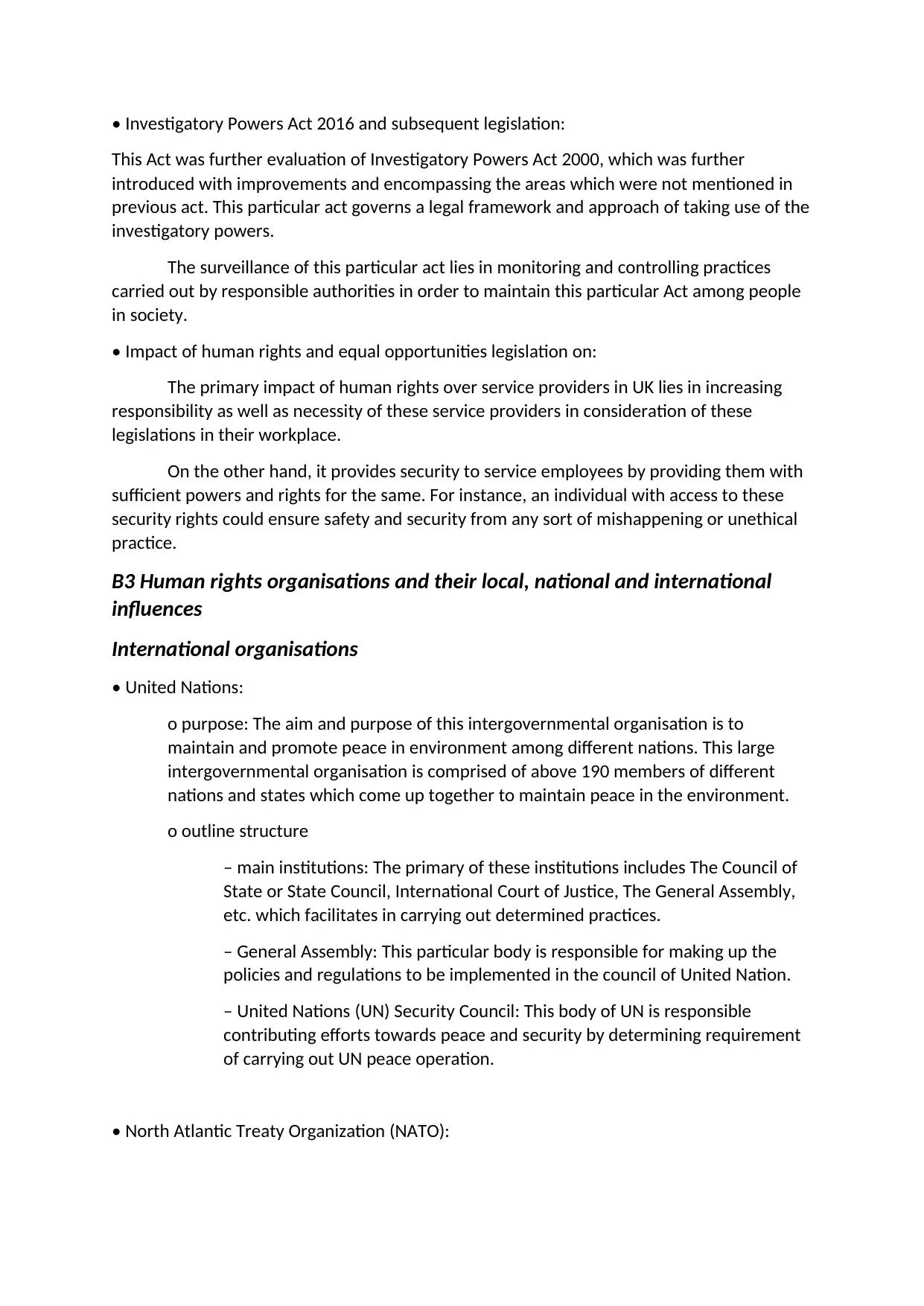
• Investigatory Powers Act 2016 and subsequent legislation:
This Act was further evaluation of Investigatory Powers Act 2000, which was further
introduced with improvements and encompassing the areas which were not mentioned in
previous act. This particular act governs a legal framework and approach of taking use of the
investigatory powers.
The surveillance of this particular act lies in monitoring and controlling practices
carried out by responsible authorities in order to maintain this particular Act among people
in society.
• Impact of human rights and equal opportunities legislation on:
The primary impact of human rights over service providers in UK lies in increasing
responsibility as well as necessity of these service providers in consideration of these
legislations in their workplace.
On the other hand, it provides security to service employees by providing them with
sufficient powers and rights for the same. For instance, an individual with access to these
security rights could ensure safety and security from any sort of mishappening or unethical
practice.
B3 Human rights organisations and their local, national and international
influences
International organisations
• United Nations:
o purpose: The aim and purpose of this intergovernmental organisation is to
maintain and promote peace in environment among different nations. This large
intergovernmental organisation is comprised of above 190 members of different
nations and states which come up together to maintain peace in the environment.
o outline structure
– main institutions: The primary of these institutions includes The Council of
State or State Council, International Court of Justice, The General Assembly,
etc. which facilitates in carrying out determined practices.
– General Assembly: This particular body is responsible for making up the
policies and regulations to be implemented in the council of United Nation.
– United Nations (UN) Security Council: This body of UN is responsible
contributing efforts towards peace and security by determining requirement
of carrying out UN peace operation.
• North Atlantic Treaty Organization (NATO):
This Act was further evaluation of Investigatory Powers Act 2000, which was further
introduced with improvements and encompassing the areas which were not mentioned in
previous act. This particular act governs a legal framework and approach of taking use of the
investigatory powers.
The surveillance of this particular act lies in monitoring and controlling practices
carried out by responsible authorities in order to maintain this particular Act among people
in society.
• Impact of human rights and equal opportunities legislation on:
The primary impact of human rights over service providers in UK lies in increasing
responsibility as well as necessity of these service providers in consideration of these
legislations in their workplace.
On the other hand, it provides security to service employees by providing them with
sufficient powers and rights for the same. For instance, an individual with access to these
security rights could ensure safety and security from any sort of mishappening or unethical
practice.
B3 Human rights organisations and their local, national and international
influences
International organisations
• United Nations:
o purpose: The aim and purpose of this intergovernmental organisation is to
maintain and promote peace in environment among different nations. This large
intergovernmental organisation is comprised of above 190 members of different
nations and states which come up together to maintain peace in the environment.
o outline structure
– main institutions: The primary of these institutions includes The Council of
State or State Council, International Court of Justice, The General Assembly,
etc. which facilitates in carrying out determined practices.
– General Assembly: This particular body is responsible for making up the
policies and regulations to be implemented in the council of United Nation.
– United Nations (UN) Security Council: This body of UN is responsible
contributing efforts towards peace and security by determining requirement
of carrying out UN peace operation.
• North Atlantic Treaty Organization (NATO):
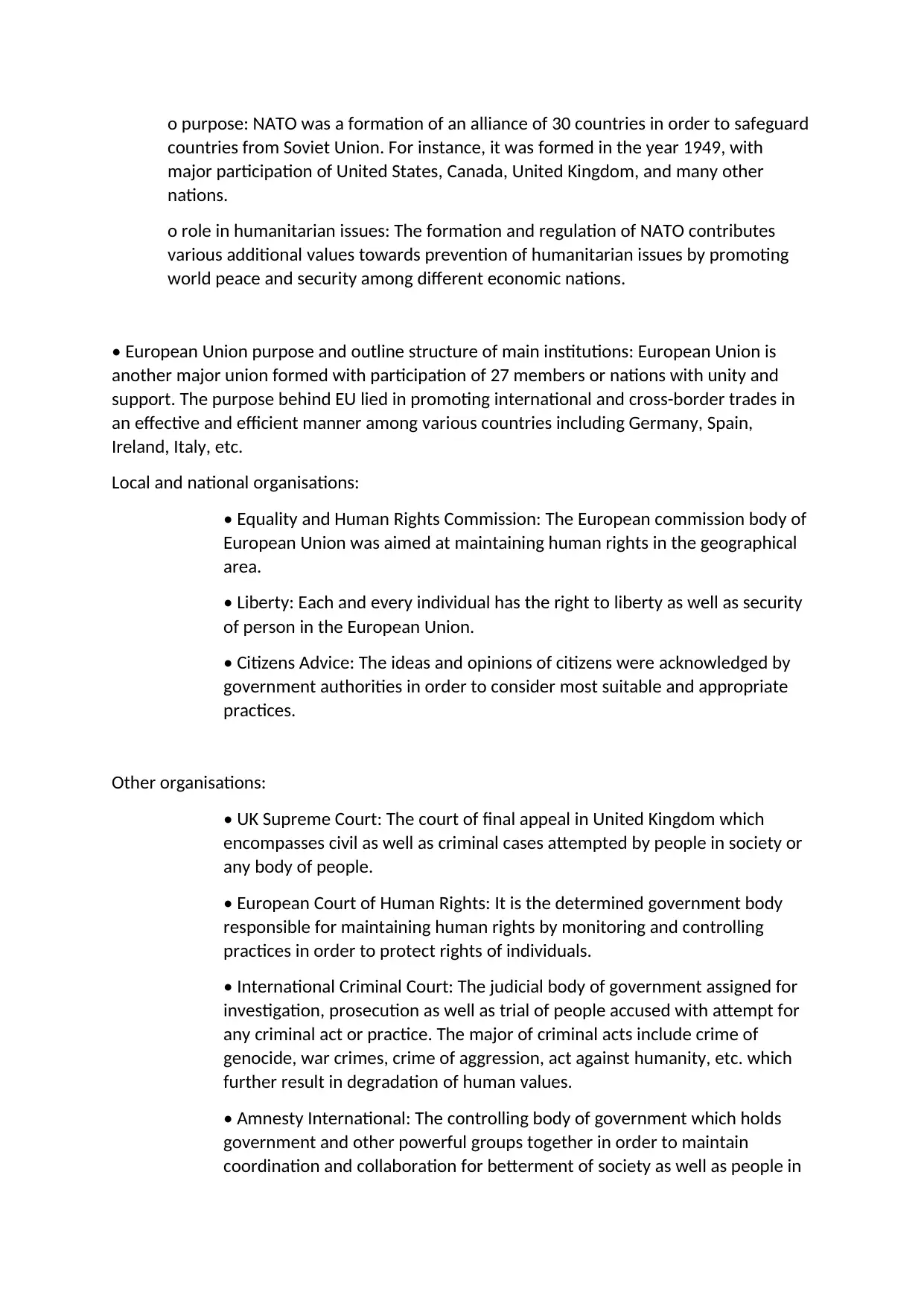
o purpose: NATO was a formation of an alliance of 30 countries in order to safeguard
countries from Soviet Union. For instance, it was formed in the year 1949, with
major participation of United States, Canada, United Kingdom, and many other
nations.
o role in humanitarian issues: The formation and regulation of NATO contributes
various additional values towards prevention of humanitarian issues by promoting
world peace and security among different economic nations.
• European Union purpose and outline structure of main institutions: European Union is
another major union formed with participation of 27 members or nations with unity and
support. The purpose behind EU lied in promoting international and cross-border trades in
an effective and efficient manner among various countries including Germany, Spain,
Ireland, Italy, etc.
Local and national organisations:
• Equality and Human Rights Commission: The European commission body of
European Union was aimed at maintaining human rights in the geographical
area.
• Liberty: Each and every individual has the right to liberty as well as security
of person in the European Union.
• Citizens Advice: The ideas and opinions of citizens were acknowledged by
government authorities in order to consider most suitable and appropriate
practices.
Other organisations:
• UK Supreme Court: The court of final appeal in United Kingdom which
encompasses civil as well as criminal cases attempted by people in society or
any body of people.
• European Court of Human Rights: It is the determined government body
responsible for maintaining human rights by monitoring and controlling
practices in order to protect rights of individuals.
• International Criminal Court: The judicial body of government assigned for
investigation, prosecution as well as trial of people accused with attempt for
any criminal act or practice. The major of criminal acts include crime of
genocide, war crimes, crime of aggression, act against humanity, etc. which
further result in degradation of human values.
• Amnesty International: The controlling body of government which holds
government and other powerful groups together in order to maintain
coordination and collaboration for betterment of society as well as people in
countries from Soviet Union. For instance, it was formed in the year 1949, with
major participation of United States, Canada, United Kingdom, and many other
nations.
o role in humanitarian issues: The formation and regulation of NATO contributes
various additional values towards prevention of humanitarian issues by promoting
world peace and security among different economic nations.
• European Union purpose and outline structure of main institutions: European Union is
another major union formed with participation of 27 members or nations with unity and
support. The purpose behind EU lied in promoting international and cross-border trades in
an effective and efficient manner among various countries including Germany, Spain,
Ireland, Italy, etc.
Local and national organisations:
• Equality and Human Rights Commission: The European commission body of
European Union was aimed at maintaining human rights in the geographical
area.
• Liberty: Each and every individual has the right to liberty as well as security
of person in the European Union.
• Citizens Advice: The ideas and opinions of citizens were acknowledged by
government authorities in order to consider most suitable and appropriate
practices.
Other organisations:
• UK Supreme Court: The court of final appeal in United Kingdom which
encompasses civil as well as criminal cases attempted by people in society or
any body of people.
• European Court of Human Rights: It is the determined government body
responsible for maintaining human rights by monitoring and controlling
practices in order to protect rights of individuals.
• International Criminal Court: The judicial body of government assigned for
investigation, prosecution as well as trial of people accused with attempt for
any criminal act or practice. The major of criminal acts include crime of
genocide, war crimes, crime of aggression, act against humanity, etc. which
further result in degradation of human values.
• Amnesty International: The controlling body of government which holds
government and other powerful groups together in order to maintain
coordination and collaboration for betterment of society as well as people in
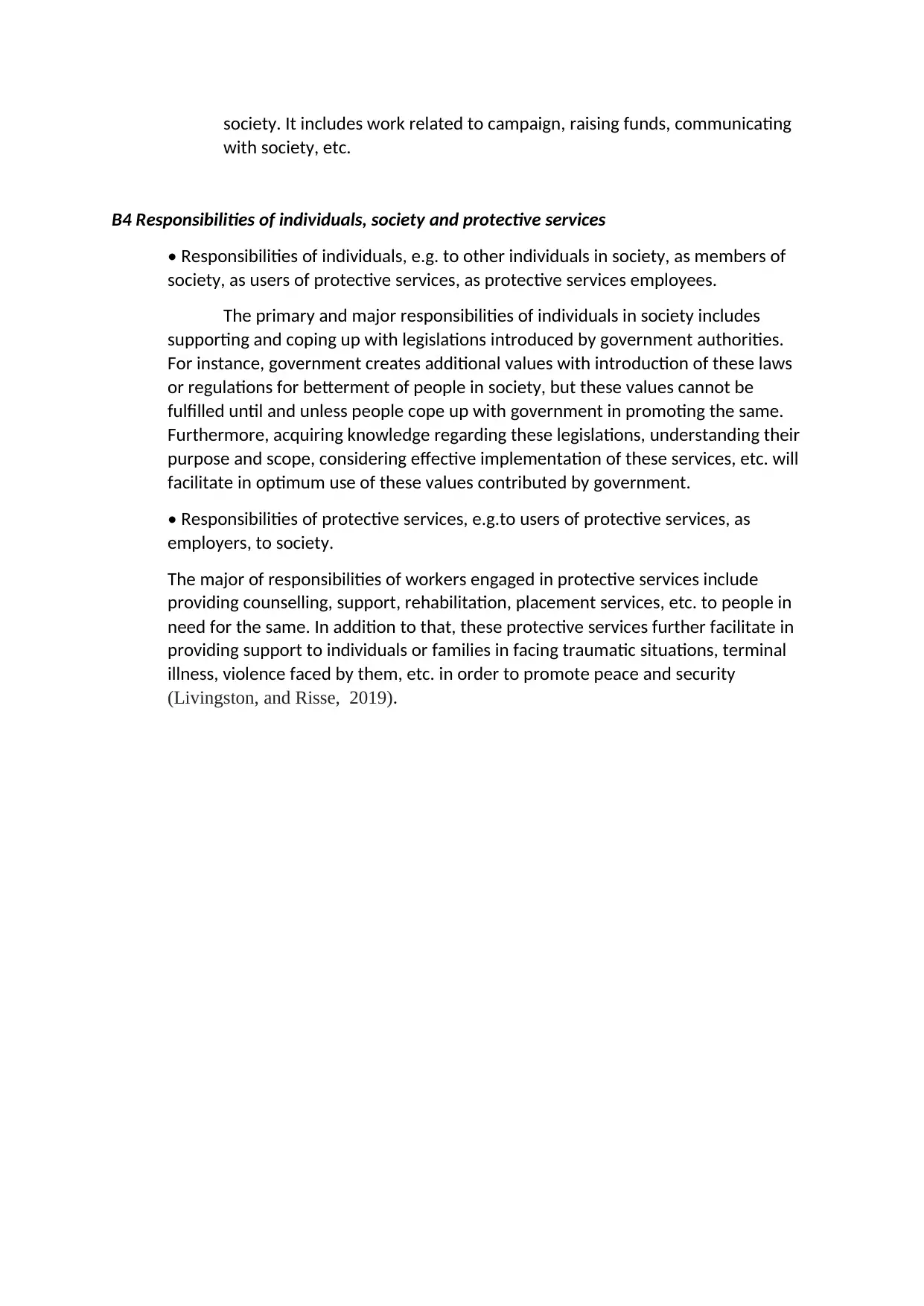
society. It includes work related to campaign, raising funds, communicating
with society, etc.
B4 Responsibilities of individuals, society and protective services
• Responsibilities of individuals, e.g. to other individuals in society, as members of
society, as users of protective services, as protective services employees.
The primary and major responsibilities of individuals in society includes
supporting and coping up with legislations introduced by government authorities.
For instance, government creates additional values with introduction of these laws
or regulations for betterment of people in society, but these values cannot be
fulfilled until and unless people cope up with government in promoting the same.
Furthermore, acquiring knowledge regarding these legislations, understanding their
purpose and scope, considering effective implementation of these services, etc. will
facilitate in optimum use of these values contributed by government.
• Responsibilities of protective services, e.g.to users of protective services, as
employers, to society.
The major of responsibilities of workers engaged in protective services include
providing counselling, support, rehabilitation, placement services, etc. to people in
need for the same. In addition to that, these protective services further facilitate in
providing support to individuals or families in facing traumatic situations, terminal
illness, violence faced by them, etc. in order to promote peace and security
(Livingston, and Risse, 2019).
with society, etc.
B4 Responsibilities of individuals, society and protective services
• Responsibilities of individuals, e.g. to other individuals in society, as members of
society, as users of protective services, as protective services employees.
The primary and major responsibilities of individuals in society includes
supporting and coping up with legislations introduced by government authorities.
For instance, government creates additional values with introduction of these laws
or regulations for betterment of people in society, but these values cannot be
fulfilled until and unless people cope up with government in promoting the same.
Furthermore, acquiring knowledge regarding these legislations, understanding their
purpose and scope, considering effective implementation of these services, etc. will
facilitate in optimum use of these values contributed by government.
• Responsibilities of protective services, e.g.to users of protective services, as
employers, to society.
The major of responsibilities of workers engaged in protective services include
providing counselling, support, rehabilitation, placement services, etc. to people in
need for the same. In addition to that, these protective services further facilitate in
providing support to individuals or families in facing traumatic situations, terminal
illness, violence faced by them, etc. in order to promote peace and security
(Livingston, and Risse, 2019).
Secure Best Marks with AI Grader
Need help grading? Try our AI Grader for instant feedback on your assignments.
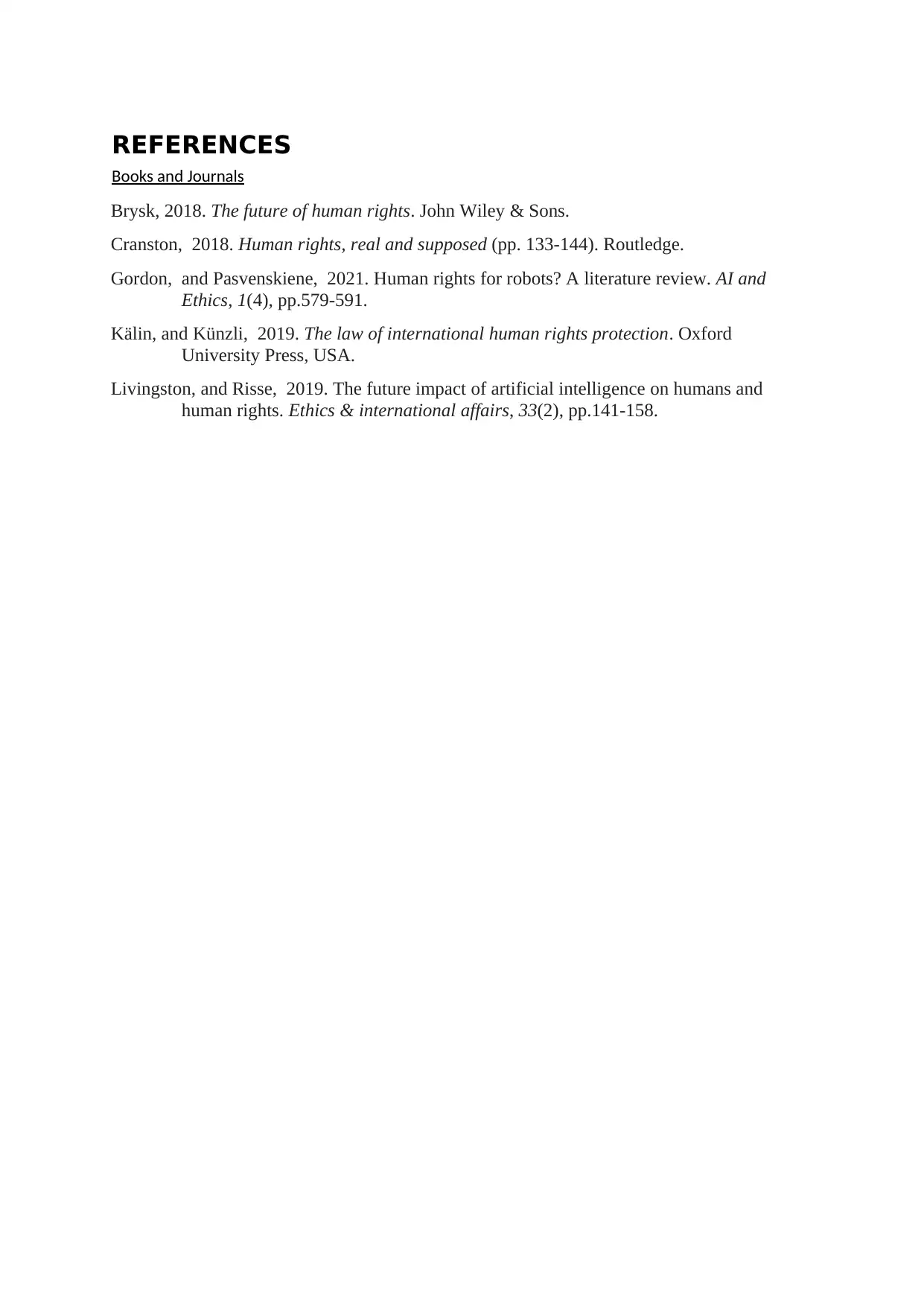
REFERENCES
Books and Journals
Brysk, 2018. The future of human rights. John Wiley & Sons.
Cranston, 2018. Human rights, real and supposed (pp. 133-144). Routledge.
Gordon, and Pasvenskiene, 2021. Human rights for robots? A literature review. AI and
Ethics, 1(4), pp.579-591.
Kälin, and Künzli, 2019. The law of international human rights protection. Oxford
University Press, USA.
Livingston, and Risse, 2019. The future impact of artificial intelligence on humans and
human rights. Ethics & international affairs, 33(2), pp.141-158.
Books and Journals
Brysk, 2018. The future of human rights. John Wiley & Sons.
Cranston, 2018. Human rights, real and supposed (pp. 133-144). Routledge.
Gordon, and Pasvenskiene, 2021. Human rights for robots? A literature review. AI and
Ethics, 1(4), pp.579-591.
Kälin, and Künzli, 2019. The law of international human rights protection. Oxford
University Press, USA.
Livingston, and Risse, 2019. The future impact of artificial intelligence on humans and
human rights. Ethics & international affairs, 33(2), pp.141-158.

Task 3
Covered in PPT
Covered in PPT
1 out of 12
Your All-in-One AI-Powered Toolkit for Academic Success.
+13062052269
info@desklib.com
Available 24*7 on WhatsApp / Email
![[object Object]](/_next/static/media/star-bottom.7253800d.svg)
Unlock your academic potential
© 2024 | Zucol Services PVT LTD | All rights reserved.